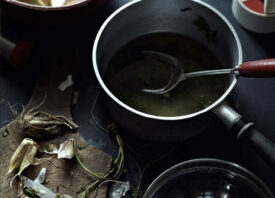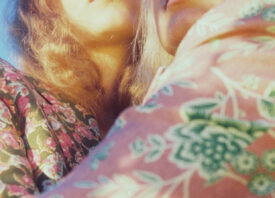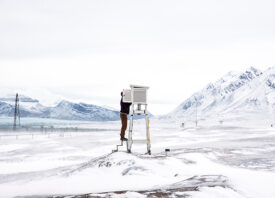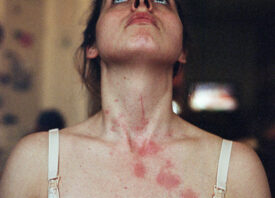Search this site
When It Comes to Hormonal Issues, Women Are Often Dismissed. This Artist Is Trying to Change That.


“For the first time, working on this series, I wasn’t overwhelmed by my discomfort,” the fine art photographer Anna Guadagnini tells me. “Instead, I was channeling it to create beauty.” She was inspired to embark on the project, The Other Side of Joy, after years of grappling with emotional and physical health issues influenced by hormonal shifts.
“For most of my adult life, I have been going through cycles of feeling like myself for a few weeks to completely falling into sadness, anxiety, and lethargy for periods of one week and sometimes longer,” the artist says. “I have been researching hormone-related issues in women for a long time. It all started in my late 20s when I decided to stop taking the contraceptive pill, as it was beginning to make me feel unwell.
“I suddenly found myself having to deal with symptoms that had been blocked by the hormonal therapy until that moment. Symptoms included mood swings, debilitating headaches, feeling out of control, suddenly feeling sad and hopeless, body aches, very painful periods, acne flare-ups, and more strange and unexpected symptoms like bleeding gums or sudden dizziness and uncontrollable hunger before a period.”
She went to the doctor, who ordered tests. She had her thyroid checked and her hormone levels checked; the bloodwork came back normal. She learned to cope on her own through herbs, supplements, and yoga. Then, recently, she learned about PMDD, Premenstrual Dysphoric Disorder, a severe and often debilitating form of PMS.
“I dug deeper and discovered forums and blogs where women were discussing these issues,” Guadagnini remembers. “I could recognize myself in their words. Most of them were talking about how they felt trapped in this endless cycle of becoming a completely different person a week or two before their periods.”
Unfortunately, despite its severity, the condition is regularly misdiagnosed. When it’s correctly diagnosed, the treatment options might include hormonal therapy, mental health therapy, antidepressants, or mood stabilizers. In severe cases, a hysterectomy might be necessary, causing the body to go directly into menopause.
“I think that this condition is still widely misunderstood and possibly overlooked,” the photographer continues. “In the medical community, from what I found in my research, there seems to be a debate on whether it is a ‘cultural bound syndrome’ or it really exists. In my opinion, based on my own experiences and those of female friends of all ages, the word that best describes the response to a woman complaining about hormonal-related symptoms is ‘dismissed.’”
Over the course of her research, the idea for the photographs began to emerge. Guadagnini has photographed herself since college, mostly out of necessity; she’s always available. But with this series, placing herself in the frame took on another layer of meaning.
“When you put yourself in front of the lens, you become part of the story you are trying to tell, and something starts happening,” she says. “It is like therapy–empowering but also difficult at times, as it makes you notice things about yourself that were hidden inside your subconscious. It becomes a process of discovery.” She worked at home in her London studio and in Italy, close to her family home, using objects that were available to her.
The artist drew inspiration from Women Who Run with the Wolves: Myths and Stories of the Wild Woman Archetype, the feminist classic by Clarissa Pinkola Estés. “I used this book as a guide, reading some of the chapters over and over and repeating sentences in my head as mantras,” Guadagnini says now.
With them, she turned more and more to the natural world, discovering motifs meant to represent “the graceful but also destructive power of Mother Nature.” She admits, “While the initial idea of the project was to raise awareness around the issue of PMDD, the series has also become a celebration of the feminine universe.
“The title of the series came from the intention of turning struggle into beauty. PMDD stands for Premenstrual Dysphoric Disorder, and I concentrated on the word ‘dysphoric,’ which is the opposite of euphoric. I wanted to emphasize the idea that weakness can be a strength. The other side of joy is not the opposite of joy. It is another way of looking at joy.”
At first, Guadagnini hesitated to release the work publicly, though remembering how she felt when she first read about PMDD–the recognition and the relief–encouraged her to take the leap. She’s glad she did.“Other women reacted by telling me their own stories, how frustrated they felt with the way they were treated at a doctor’s appointment, or just how they could relate in some way to my experience,” she says.

“I am starting to collect experiences from the people around me and reach out to online communities presenting my work in the hope that others will want to share their thoughts and experiences with me. I am planning to collect these reactions and intertwine them with my work.” In one photograph, Fragments, she’s physically incorporated the words of other women, printed on torn pages.
For the artist herself, making this work has been cathartic and healing. She still remembers going outside at night to shoot Insomnia and Lethargy. Her friends helped bring her vision to life. In those two photographs, she’s on a bed, surrounded by red flower petals. Her hair forms a blindfold, obscuring her view. The landscape is mysterious, shadowy, and just beyond reach. Looking back, she says it was a magical evening, the air thick with wonder and awe. She felt at peace with the darkness.






All images © Anna Guadagnini



